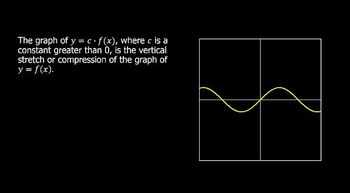Table of contents
- 0. Review of Algebra4h 16m
- 1. Equations & Inequalities3h 18m
- 2. Graphs of Equations43m
- 3. Functions2h 17m
- 4. Polynomial Functions1h 44m
- 5. Rational Functions1h 23m
- 6. Exponential & Logarithmic Functions2h 28m
- 7. Systems of Equations & Matrices4h 6m
- 8. Conic Sections2h 23m
- 9. Sequences, Series, & Induction1h 19m
- 10. Combinatorics & Probability1h 45m
3. Functions
Transformations
Problem 47b
Textbook Question
Without graphing, determine whether each equation has a graph that is symmetric with respect to the x-axis, the y-axis, the origin, or none of these. See Examples 3 and 4. x^2+y^2=12
 Verified step by step guidance
Verified step by step guidance1
Identify the type of equation: The given equation \(x^2 + y^2 = 12\) is a circle centered at the origin with radius \(\sqrt{12}\).
Test for symmetry with respect to the x-axis: Replace \(y\) with \(-y\) in the equation to see if the equation remains unchanged. Substitute to get \(x^2 + (-y)^2 = 12\), which simplifies to \(x^2 + y^2 = 12\). The equation remains unchanged, indicating symmetry with respect to the x-axis.
Test for symmetry with respect to the y-axis: Replace \(x\) with \(-x\) in the equation to see if the equation remains unchanged. Substitute to get \((-x)^2 + y^2 = 12\), which simplifies to \(x^2 + y^2 = 12\). The equation remains unchanged, indicating symmetry with respect to the y-axis.
Test for symmetry with respect to the origin: Replace \(x\) with \(-x\) and \(y\) with \(-y\) in the equation to see if the equation remains unchanged. Substitute to get \((-x)^2 + (-y)^2 = 12\), which simplifies to \(x^2 + y^2 = 12\). The equation remains unchanged, indicating symmetry with respect to the origin.
Conclude the symmetries: Since the equation is unchanged for all three tests, the graph of the equation is symmetric with respect to the x-axis, the y-axis, and the origin.
Recommended similar problem, with video answer:
 Verified Solution
Verified SolutionThis video solution was recommended by our tutors as helpful for the problem above
Video duration:
1mPlay a video:
Was this helpful?
Key Concepts
Here are the essential concepts you must grasp in order to answer the question correctly.
Symmetry with respect to the x-axis
An equation is symmetric with respect to the x-axis if replacing y with -y yields an equivalent equation. This means that for every point (x, y) on the graph, the point (x, -y) will also be on the graph. This type of symmetry indicates that the graph is mirrored across the x-axis.
Recommended video:

Properties of Parabolas
Symmetry with respect to the y-axis
An equation is symmetric with respect to the y-axis if replacing x with -x results in an equivalent equation. This implies that for every point (x, y) on the graph, the point (-x, y) will also be present. Such symmetry suggests that the graph is mirrored across the y-axis.
Recommended video:

Properties of Parabolas
Symmetry with respect to the origin
An equation is symmetric with respect to the origin if replacing both x with -x and y with -y yields an equivalent equation. This means that for every point (x, y) on the graph, the point (-x, -y) will also be on the graph. This type of symmetry indicates that the graph has rotational symmetry of 180 degrees around the origin.
Recommended video:

Graph Hyperbolas NOT at the Origin

 5:25m
5:25mWatch next
Master Intro to Transformations with a bite sized video explanation from Nick Kaneko
Start learningRelated Videos
Related Practice


























